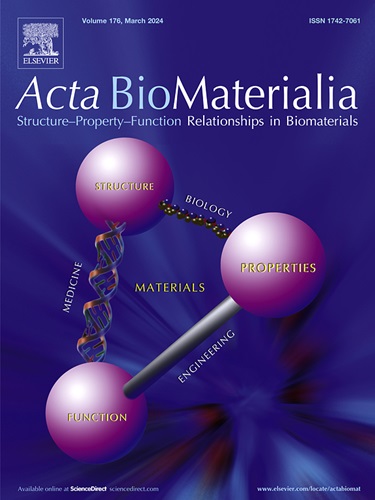Design and advances in antioxidant hydrogels for ROS-induced oxidative disease
IF 9.4
1区 医学
Q1 ENGINEERING, BIOMEDICAL
引用次数: 0
Abstract
Reactive oxygen species (ROS) play a crucial role in human physiological processes, but oxidative stress caused by excessive ROS may lead to a variety of acute and chronic diseases. Despite the development of various strategies and biomaterials, an efficiently and broadly applied method for treatment of ROS-induced oxidative disease remains a bottleneck. Aiming to improve the local oxidative stress environment, numerous bioactive hydrogels with antioxidant properties have emerged and are proven to quickly and continuously eliminate excessive ROS. To deeply understand the design principles and applications of antioxidant hydrogels is highly beneficial for designing antioxidant hydrogels for treatment of oxidative disease. This review provides a detailed summary of recent advances in design and applications of antioxidant hydrogels for various ROS-induced oxidative diseases. In this review, the kinds of antioxidant components in antioxidant hydrogels are outlined in detail. Additionally, the crosslinking methods and the biomedical applications of antioxidant hydrogels are widely summarized and discussed, especially focusing on their usage in different types of diseases and the attention given to the treatment of diseases such as skin wounds, myocardial infarction, and osteoarthritis. Finally, the future development direction of antioxidant hydrogel is further proposed.
Statement of significance
Oxidative stress is a pivotal biochemical process that plays a critical role in cellular homeostasis. Excessive cellular oxidative stress triggers an inflammatory response, which is implicated in a spectrum of associated diseases. Given the critical need for managing oxidative stress, antioxidant therapies have become a vital focus in medical research. Hydrogels have garnered substantial interest among biomaterial scientists due to their hydrophilic nature and biocompatibility. The review delves into the realm of antioxidant hydrogels, encompassing the classification of antioxidant components, the synthesis and fabrication of hydrogels, and a comprehensive overview of the biological applications and challenges of these antioxidant hydrogels. Aiming to provide new perspectives for researchers in developing cutting-edge therapeutic approaches that leverage antioxidant hydrogels.

求助全文
约1分钟内获得全文
求助全文
来源期刊

Acta Biomaterialia
工程技术-材料科学:生物材料
CiteScore
16.80
自引率
3.10%
发文量
776
审稿时长
30 days
期刊介绍:
Acta Biomaterialia is a monthly peer-reviewed scientific journal published by Elsevier. The journal was established in January 2005. The editor-in-chief is W.R. Wagner (University of Pittsburgh). The journal covers research in biomaterials science, including the interrelationship of biomaterial structure and function from macroscale to nanoscale. Topical coverage includes biomedical and biocompatible materials.
 求助内容:
求助内容: 应助结果提醒方式:
应助结果提醒方式:


